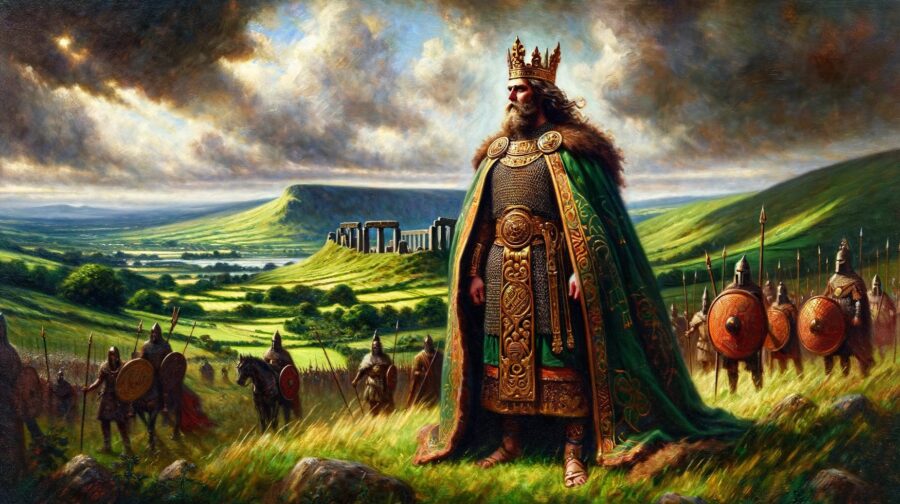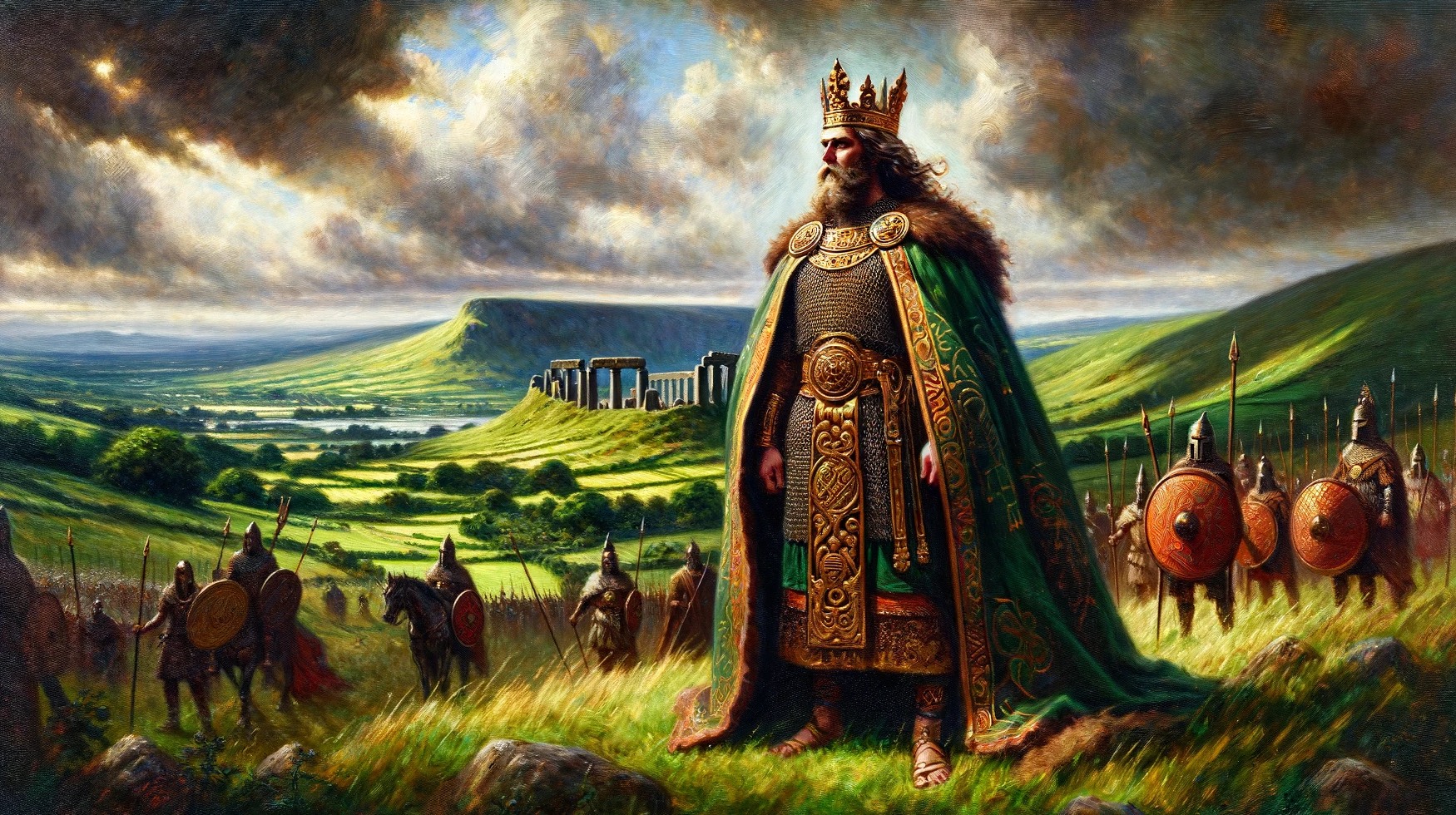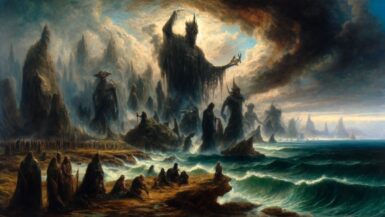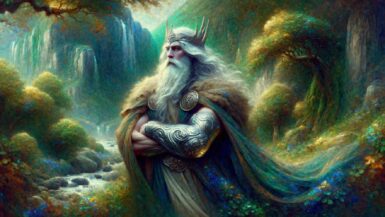Conchobar mac Nessa, a legendary figure steeped in the rich tapestry of Irish mythology, stands as one of the most compelling rulers of ancient Ulster. As the king of Ulster, Conchobar’s tales are central to the Ulster Cycle, a collection of mythological sagas that encapsulate heroism, conflict, and tragedy in pre-Christian Ireland. His narrative intertwines with the lives of notable figures such as the warrior Cú Chulainn and Queen Medb, adding layers to the epic accounts of battles, politics, and personal vendettas.
This article aims to explore the life and legacy of Conchobar mac Nessa, tracing his origins, his ascent to power, and his role within the broader context of Irish folklore. We will delve into his strategic political maneuvers, his familial and interpersonal relationships, and the cultural significance that cements his status as a mythological icon. By examining these facets, the article will provide a comprehensive understanding of Conchobar’s impact on Irish mythology and his enduring influence in literary and cultural studies.
Contents
Early Life and Origins
The genesis of Conchobar mac Nessa is shrouded in mysticism and varying narratives, each rich with the allure of ancient Irish tradition. His parentage and birth are central themes in these tales, often linked to divine prophecies and significant figures of his time, setting the stage for his future as a king of unparalleled influence.
Parentage
The most commonly accepted version of Conchobar’s origin states that he is the son of Ness, the daughter of Eochaid Sálbuide, the then king of Ulster. However, the identity of his father is a subject of different accounts: some say he is the son of Fachtna Fáthach, the High King of Ireland, while others suggest his father is Cathbad, the chief druid. The latter version holds a particularly intriguing twist—Ness, guided by Cathbad’s prophecy that it was an auspicious time for begetting a king, seduces Cathbad, resulting in Conchobar’s conception.
Connection to Cathbad and Fachtna Fáthach
Cathbad’s role extends beyond that of a progenitor; he is often depicted as a mentor and protector to Conchobar, imbuing the young prince with the wisdom and foresight necessary for kingship. On the other hand, Fachtna Fáthach, as a High King, symbolically represents a royal lineage that lends further legitimacy and stature to Conchobar’s rule in Ulster. These connections to figures of power and mysticism significantly shaped Conchobar’s destiny and his perception among the Ulaid.
The Prophecy
A pivotal element in the narrative of Conchobar’s early life is the prophecy made at his conception. Cathbad’s declaration that the time was right for the birth of a king not only set the course for Conchobar’s life but also positioned him as a figure of destiny from the very start. This prophecy suggested that Conchobar was destined for greatness, to rule with strength and wisdom. Such prophecies were not merely foretellings of future events but were seen as divine mandates, imbuing Conchobar’s eventual kingship with a sense of inevitability and divine right.
The implications of this prophecy resonate throughout Conchobar’s life and reign. It instilled in him a sense of duty and destiny, influencing his decisions and his interactions with allies and enemies alike. This narrative of divine ordination also reinforced his authority among his people, lending a sacred legitimacy to his rule that was recognized across Ulster.
Rise to Power
Conchobar mac Nessa’s ascension to the throne of Ulster is a tale of cunning, prophecy, and strategic marital alliances, illustrating the complex social and legal norms of ancient Irish society. His rise to power was not merely a function of lineage or conquest but involved significant maneuvering influenced by his mother, Ness, and the prevailing legal traditions of the time.
The Story of Fergus mac Róich
The pivotal moment in Conchobar’s path to kingship involved Fergus mac Róich, the reigning king of Ulster. Fergus, known for his strength and valor, fell deeply in love with Ness. She agreed to marry him but set a crucial condition: Conchobar, though still a child, must be made king for a year. This condition was ostensibly to honor the prophecy that Conchobar was destined to be king, and to ensure that his future offspring could claim descent from a king, a significant factor in royal legitimacy.
Fergus, deeply enamored and perhaps underestimating the implications, consented to this arrangement. Conchobar was installed as a nominal king, with the expectation that this would be a temporary arrangement before Fergus resumed his rule.
Ness’s Strategy and Conchobar’s Rule
However, Ness had a strategic plan to ensure her son’s prolonged reign. During his year as king, Conchobar, guided by his mother’s counsel and the druidic wisdom of Cathbad, governed wisely and justly, far beyond the expectations for a boy king. His rule was marked by decisions that showcased his ability to lead, which ingratiated him with the Ulster nobility and the common people alike.
As the end of the year approached, the nobles of Ulster, pleased with Conchobar’s leadership, advocated for his continuation as king. Fergus, bound by his promise and faced with the undeniable popularity of Conchobar’s rule, was compelled to step down. Thus, Conchobar was solidified in power, not just by the machinations of his mother but by the will of the Ulaid people.
Legal and Social Context
Under medieval Irish law, particularly the Brehon laws, kingship was not solely hereditary but elective within certain royal kin groups. A king’s fitness to rule, his fír flathemon (king’s truth), was judged by his ability to ensure prosperity in his territory — signified by bountiful harvests, successful raids, and effective leadership. Conchobar’s ability to demonstrate these qualities during his interim rule significantly legitimized his claim to the throne.
Moreover, the concept of tanistry allowed for an heir (the tánaiste) to be appointed and recognized while the current king still lived. This practice was meant to ensure smooth successions but often led to power struggles. In Conchobar’s case, his designated year as king acted as a proof of his capability, effectively manipulating these traditions to secure his position permanently.
Thus, Conchobar mac Nessa’s rise to power is emblematic of the nuanced interplay between personal ambition, legal norms, and societal expectations in ancient Irish royalty. His continued reign after the temporary term was a testament to his strategic governance and the successful exploitation of both legal structures and personal relationships.
Reign as King
Conchobar mac Nessa’s tenure as the king of Ulster is marked by significant political maneuvering, strategic alliances, and military campaigns that have cemented his legacy as a formidable and astute ruler in Irish mythology. His reign, while characterized by periods of prosperity and strength, was also fraught with challenges that tested his leadership and tactical acumen.
Governance and Political Landscape
During Conchobar’s reign, Ulster stood as a stronghold of stability and power, largely due to his effective governance. Conchobar was known for his judicious administration, which was guided by both the traditional wisdom of the druids and the counsel of his advisers. The king’s rule was marked by a strong adherence to the Brehon Laws, ancient Irish legal statutes that governed everything from property rights to tribal customs. His ability to maintain law and order, ensure justice, and promote prosperity greatly enhanced his reputation among his subjects.
The political landscape of Ulster under Conchobar was one of constant vigilance and strategic defense. Positioned against rivals from within the other provinces of Ireland, particularly Connacht under Queen Medb, Ulster under Conchobar’s rule often found itself at the nexus of broader regional conflicts, which the king navigated with a blend of diplomacy and martial prowess.
Significant Policies and Military Campaigns
One of the most notable aspects of Conchobar’s reign was his military strategy. He was not only a warrior king but also a tactician who understood the importance of strong defense and the strategic use of alliances. His policies often focused on strengthening the fortifications of Emain Macha, the capital of Ulster, and securing the loyalty of his warriors through grants of land and wealth.
The most famous military campaign during his reign was the Táin Bó Cúailnge, or the Cattle Raid of Cooley. This conflict was initiated by Queen Medb of Connacht in a bid to capture the prized bull Donn Cúailnge, symbolizing her challenge to Conchobar’s authority. The epic battle not only tested the military might of Ulster but also highlighted Conchobar’s leadership qualities and his ability to mobilize and inspire his warriors during times of crisis.
Relationships with Key Figures
Conchobar’s relationships with key figures such as Cú Chulainn, the legendary hero of Ulster, and Queen Medb, his nemesis from Connacht, significantly shaped his reign.
- Cú Chulainn: Conchobar’s relationship with his nephew Cú Chulainn was complex. As the foremost warrior of Ulster, Cú Chulainn was essential to the king’s military strategies, particularly during the Táin Bó Cúailnge. Conchobar relied heavily on Cú Chulainn’s almost superhuman abilities on the battlefield, which were crucial in thwarting Medb’s invasion. However, their relationship was not without its tensions, often due to Conchobar’s strategic decisions that put Cú Chulainn at great personal risk and the young hero’s sometimes uncontrollable nature.
- Queen Medb: The dynamic between Conchobar and Queen Medb was one of rivalry and grudging respect. Medb’s ambition and her challenge to Ulster’s dominance were a constant thorn in Conchobar’s side. Their interactions, a blend of political and personal conflict, underscored many of the era’s significant events, including the Táin Bó Cúailnge, which not only was a military conflict but also a profound narrative about power, greed, and heroism.
Personal Life and Relationships
Conchobar mac Nessa’s personal life, characterized by numerous marriages, familial alliances, and complex interpersonal relationships, played a crucial role in shaping his reign as the king of Ulster. These relationships not only influenced his domestic policies but also had significant repercussions for the political landscape of his time.
Marriages and Family Dynamics
Conchobar was known for his multiple marriages, which were often strategically aligned to strengthen his political alliances and secure his position in Ulster. His wives included noblewomen from various territories, each marriage bringing with it new alliances and occasionally, new conflicts.
- Medb (Maeve): Perhaps the most famous of his wives, Medb later became the queen of Connacht. Their marriage, though politically advantageous at the outset, ended in separation due to Medb’s ambition and her desire for power, which clashed with Conchobar’s own leadership. Medb’s departure and subsequent marriage to Ailill of Connacht laid the groundwork for future conflicts, most notably the Táin Bó Cúailnge.
- Mugain: Considered his chief wife, Mugain bore him several children, helping to secure his lineage. Her role in the royal court was significant, often acting as a stabilizing influence within the family and the kingdom.
- Other Marriages: Conchobar’s other marriages to women such as Eithne and Clothru (both potentially his relatives in certain stories), further complicated the family dynamics, particularly with the overlapping familial roles and allegiances they brought into the royal household.
Children
Conchobar’s children, including notable figures like Cormac Cond Longas and Cúscraid Mend Macha, were integral to his legacy. Each child was strategically fostered with allies across Ulster and beyond, as was customary for the time, to cement alliances and educate the next generation of leaders under the tutelage of trusted nobles.
Complex Relationships
- Deirdre: The story of Deirdre is one of the most poignant tales associated with Conchobar. Deirdre, destined to be a woman of great beauty whose life would lead to much strife, was sought by Conchobar for marriage. However, her elopement with Naoise, son of Uisnech, led to one of the most tragic tales in Irish mythology. Conchobar’s obsession with Deirdre and his subsequent actions to reclaim her after she had fled with Naoise led to the death of her lover and his brothers, deeply tarnishing Conchobar’s reputation and setting the stage for further conflicts.
- Fergus mac Róich: Fergus, initially a king of Ulster who stepped down in favor of Conchobar, became one of his most formidable rivals. Although Fergus’s relationship with Conchobar started amicably, with Fergus acting as a mentor and supporter, it deteriorated after Conchobar’s permanent accession to the throne and his betrayal during the Deirdre saga. This betrayal led Fergus to defect to Connacht, where he aligned with Queen Medb against Conchobar, significantly influencing the dynamics of power in Ireland.
Conchobar mac Nessa’s personal relationships profoundly impacted his reign and the narrative arcs within the Ulster Cycle. His marriages shaped the political alliances of Ulster, his familial strategies influenced the future leadership of the region, and his complex interactions with figures like Deirdre and Fergus mac Róich underscored the intertwining of personal motives with political outcomes in ancient Irish kingship.
Cultural and Mythological Significance
Conchobar mac Nessa’s role in Irish folklore and myth extends beyond his historical or legendary actions as king; it delves into the realms of symbolism and cultural ethos, reflecting the values, fears, and aspirations of ancient Irish society. His character and the stories that surround him serve as a rich tapestry of meaning and insight into the complex dynamics of power, morality, and fate in Irish mythology.
Role in Irish Folklore and Myth
Conchobar is central to the Ulster Cycle, one of the four major cycles of Irish mythology, which is pivotal in showcasing the heroic age of Ireland. His leadership during the iconic Táin Bó Cúailnge and other tales not only highlights his prowess and political acumen but also underscores the cultural importance of kingship and sovereignty in ancient Ireland. Conchobar embodies the archetypal king, whose actions directly influence the welfare of his people and land, adhering to the concept of fír flathemon—the truth of the ruler which ensures peace and prosperity under his rule.
Symbolic Aspects of His Character
- Symbol of Kingship and Authority: Conchobar represents the ideal of kingship in Irish myth, where the king is not just a political leader but also a semi-sacred figure whose personal morality and physical well-being are symbiotically linked with the land he governs. This connection is evident in the prosperity of Ulster under his rule, reflecting the mythological concept that the land flourishes under a just and strong king.
- Agent of Fate and Prophecy: Conchobar’s life is profoundly shaped by prophecies and omens, from the circumstances of his birth to his tragic death. These elements highlight the Celtic belief in the power of fate and destiny, where even kings are not beyond the reach of preordained paths set by the supernatural forces of the cosmos. His interactions with figures like Cathbad, who foretells his birth and the calamitous love story of Deirdre, further cement his role as a figure caught in the web of destiny.
- Complexity of Leadership: Conchobar’s stories often explore the burdens and moral complexities of leadership. His decision-making, particularly in situations involving Deirdre or during the Táin, reflects the intricate balance between personal desires and the greater good. These narratives serve as a reflection on the ethical dimensions of power and the consequences of decisions, providing moral lessons on governance and justice.
- Embodiment of Cultural Values: Through his patronage of heroes like Cú Chulainn and his engagement in activities typical of Irish kings—such as feasting, presiding over assemblies, and leading in war—Conchobar embodies the cultural ideals of hospitality, honor, and valor. His court at Emain Macha is depicted as a center of culture and heroism, reflecting the societal values of the time.
Conchobar mac Nessa, through his mythological narratives, serves not only as a historical or legendary figure but as a cultural symbol that encapsulates the complexities of kingship, the inevitability of fate, and the moral quandaries faced by those in power. His stories are integral to understanding the cultural and mythological landscape of ancient Ireland, offering insights into the values and conflicts of its people. Through these tales, Conchobar remains a perennial figure in the collective Irish consciousness, representing the timeless themes of leadership, morality, and destiny.
Legacy and Influence
Conchobar mac Nessa’s legacy extends far beyond the ancient manuscripts and myths of Ireland. His influence permeates through history and modern culture, shaping perceptions of kingship and heroism and inspiring a myriad of literary works and characters in later traditions. His complex character and the epic narratives surrounding his reign have been interpreted and reinterpreted, influencing both literary forms and cultural ideologies.
Historical and Modern Perceptions
Historically, Conchobar has been viewed as a quintessential king whose reign embodies the ideals and complexities of Iron Age Ireland. In medieval Irish literature, he is portrayed as a formidable yet fair ruler, often serving as a benchmark against which other kings are measured. In modern times, Conchobar’s tales, particularly those involving themes of love, betrayal, and tragedy, resonate with contemporary audiences for their depth and relevance to themes of leadership and morality.
The portrayal of Conchobar in modern culture often reflects a fascination with mythological narratives, where ancient tales are reimagined to explore universal themes of power, ethics, and human frailty. Conchobar’s character is sometimes seen through a critical lens, particularly regarding his decisions and moral judgements, which are dissected for their impact on the lives of legendary heroes like Cú Chulainn and tragic figures like Deirdre.
Impact on Other Literary Works
Conchobar mac Nessa’s influence is notably visible in the Arthurian legends, which share several thematic and structural similarities with the Ulster Cycle. Scholars have long noted parallels between Conchobar and King Arthur, particularly in their roles as royal patrons of groups of heroic warriors—Conchobar with the Red Branch Knights and Arthur with the Knights of the Round Table. Both figures are central to tales that define the cultural and mythical landscape of their respective societies.
The tragic elements of Conchobar’s stories, such as the doomed love of Deirdre, akin to the Arthurian love triangles and betrayals, highlight the shared narrative motifs between Celtic myths and later medieval romances. These stories explore the consequences of royal decisions and personal desires, weaving complex tapestries of fate and agency that challenge and intrigue audiences across the ages.
Influence on Characters and Storytelling
Conchobar has possibly influenced the depiction of other literary characters who embody the dual aspects of wisdom and fallibility in leadership. His narrative has enriched the portrayal of nuanced characters who are revered not only for their strength and authority but also for their human vulnerabilities and moral conflicts.
Moreover, the rich saga of Conchobar and the Ulster Cycle has contributed to the broader genre of epic literature, where themes of heroism, loyalty, betrayal, and destiny are explored in depth. These themes continue to resonate in contemporary storytelling, where the blend of historical depth and mythological wonder continues to captivate and inspire both creators and audiences.







My Grand mother is a Decendant of Conchiobar she is decended form.kings that go back past 200Ad Maeilus Father Irish King Msc of Spain also